肺鳞癌驱动基因研究进展_洪卫
最新:晚期驱动基因阳性非小细胞肺癌免疫治疗专家共识(全文)
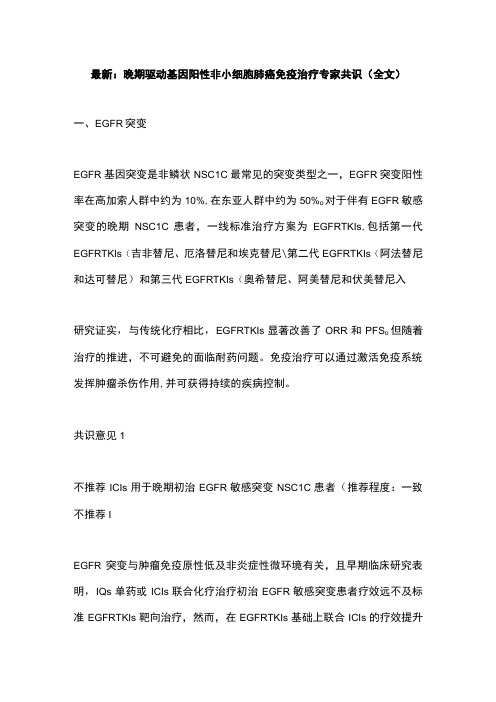
最新:晚期驱动基因阳性非小细胞肺癌免疫治疗专家共识(全文)一、EGFR突变EGFR基因突变是非鳞状NSC1C最常见的突变类型之一,EGFR突变阳性率在高加索人群中约为10%,在东亚人群中约为50%o对于伴有EGFR敏感突变的晚期NSC1C患者,一线标准治疗方案为EGFRTKIs,包括第一代EGFRTKIs(吉非替尼、厄洛替尼和埃克替尼\第二代EGFRTKIs(阿法替尼和达可替尼)和第三代EGFRTKIs(奥希替尼、阿美替尼和伏美替尼入研究证实,与传统化疗相比,EGFRTKIs显著改善了ORR和PFS o但随着治疗的推进,不可避免的面临耐药问题。
免疫治疗可以通过激活免疫系统发挥肿瘤杀伤作用,并可获得持续的疾病控制。
共识意见1不推荐ICIs用于晚期初治EGFR敏感突变NSC1C患者(推荐程度:一致不推荐IEGFR突变与肿瘤免疫原性低及非炎症性微环境有关,且早期临床研究表明,IQs单药或ICIs联合化疗治疗初治EGFR敏感突变患者疗效远不及标准EGFRTKIs靶向治疗,然而,在EGFRTKIs基础上联合ICIs的疗效提升有限,且存在较大安全性风险。
共识意见2推荐耐药的EGFR突变患者再次活检,同时检测肿瘤耐药基因和免疫微环境相关的生物标志物(推荐程度:一致推荐工基于EGFRTKIs治疗会影响肿瘤特征和及肿瘤微环境(TME),建议条件允许的情况下应再次活检,为后续精准治疗提供依据。
检测标本优选肿瘤组织,组织标本无法获得时可以采用其他类型标本替代;检测范围优选高通量检测以获得全面的耐药信息,包括肿瘤相关和免疫微环境相关的生物标志物。
共识意见3对于EGFRTKIs耐药后发生广泛进展的患者,且在缺乏有效靶向治疗的情况下,推荐使用ICIs(推荐程度:一致推荐\对于ICIS的方案选择,应结合患者的体能状态和疾病进展情况进行综合判断,其中IC1s+化疗+抗血管治疗方案的临床证据较为丰富(推荐程度:强推荐);IQs+含粕化疗方案在多项早期研究中均显示良好的治疗活性,且耐受性方面ICIs+含粕化疗方案较ICIs+含粕化疗+抗血管联合方案具有一定优势(推荐程度:强推荐);ICIs联合抗血管治疗(推荐程度:弱推荐)的证据主要针对多线耐药的患者或体力状况较差不耐受高强度治疗的患者,疗效获益有限。
肺癌驱动基因的研究和EGFRTKI以外的靶向治疗研究进展(施春雷)

9.2
N=172
Erlotinib trials
OPTIMAL4 N= 154
13.7
EURTAC5 N=174
10.4
Afatinib trial
LUX-LUNG- 3
13.6
N=345
PFS
化疗组 6.3 5.4 6.3
4.6 5.4
6.9
HR
EGFR TKI组
0.48
21.6
p<0.001
0.36
GSK1120212、AZD6244和AS703026。 ALK融合:肺腺癌中约9.6%。 MET:MET在肺癌中有时突变和(或)扩增;XL184、ARQ-917和
Metmab等。 其他:
– HER2突变或扩增:曲妥珠单抗、拉帕替尼与PF 299804等 – PI3K突变或扩增:GDC-0941、XL-147、XL-765、PX-866、BEZ-235与
19.5
1.04(0.65-1.68)#
EGFR突变肺癌PFS与OS 关系 靶向与化疗均不可或缺
PFS(月) OS(月) OS-FPS(月)
临床研究 靶向贡献 靶向+化疗 化疗贡献
IPASS
9.5
21.6
12.4
NEJ002
10.8
27.7
16.9
WJTOG3405
9.2
36
26.8
OPTIMAL
EML4-ALK抑制剂
免疫调节剂
蛋白酶体抑制剂
HDAC抑制剂
代表药物 单靶点可逆:吉非替尼、厄洛替尼 单靶点不可逆:EKB-569、CL-387 多靶点不可逆:HKI-272、卡奈替尼、
PF-00299804、BIBW 2992 西妥昔单抗 贝伐单抗 索拉非尼、凡德他尼、舒尼替尼、Cediranib AVE0005 恩度
基因驱动阳性晚期NSCLC一线免疫治疗

基因驱动阳性晚期NSCLC一线免疫治疗
简介
本文档旨在探讨基因驱动阳性晚期非小细胞肺癌(NSCLC)一线免疫治疗的相关信息。
NSCLC是一种常见的肺癌类型,基因驱动阳性NSCLC是一种具有特定基因突变的亚型。
基因驱动阳性NSCLC概述
基因驱动阳性NSCLC是指肺癌细胞中存在特定基因的突变,这些突变可能导致肿瘤细胞的生长和扩散。
常见的基因突变包括EGFR、ALK、ROS1等。
一线免疫治疗
一线免疫治疗是指在NSCLC患者初始治疗阶段,使用免疫治疗药物作为首选治疗方法。
免疫治疗药物通过激活患者自身的免疫系统来攻击肿瘤细胞。
基因驱动阳性NSCLC一线免疫治疗的意义
基因驱动阳性NSCLC患者在接受免疫治疗时可能有更好的治
疗效果。
根据不同的基因突变,可以选择相应的靶向免疫治疗药物,提高治疗的针对性和效果。
具体治疗方案
针对不同的基因突变,基因驱动阳性NSCLC患者可以选择合
适的免疫治疗方案。
例如,EGFR突变的患者可以使用特定的
EGFR靶向免疫治疗药物。
治疗方案的选择应根据医生的建议和患
者的具体情况来确定。
结论
基因驱动阳性晚期NSCLC一线免疫治疗是一种具有潜力的治
疗方法。
通过基因检测和采用相应的免疫治疗药物,可以提高患者
的治疗效果和生存率。
然而,具体的治疗方案需要根据患者的基因
情况和医生的指导进行个性化选择。
以上是对基因驱动阳性晚期NSCLC一线免疫治疗的简要介绍。
如需更详细的信息,请咨询专业医生或查阅相关研究文献。
晚期驱动基因阳性NSCLC免疫治疗专家共识
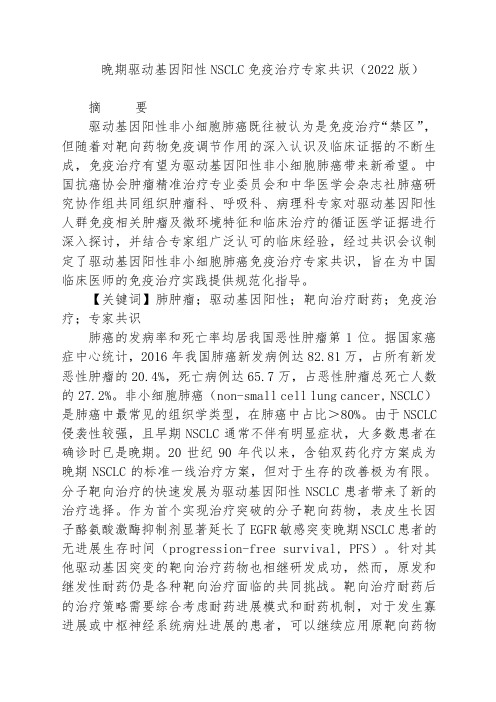
晚期驱动基因阳性NSCLC免疫治疗专家共识(2022版)摘要驱动基因阳性非小细胞肺癌既往被认为是免疫治疗“禁区”,但随着对靶向药物免疫调节作用的深入认识及临床证据的不断生成,免疫治疗有望为驱动基因阳性非小细胞肺癌带来新希望。
中国抗癌协会肿瘤精准治疗专业委员会和中华医学会杂志社肺癌研究协作组共同组织肿瘤科、呼吸科、病理科专家对驱动基因阳性人群免疫相关肿瘤及微环境特征和临床治疗的循证医学证据进行深入探讨,并结合专家组广泛认可的临床经验,经过共识会议制定了驱动基因阳性非小细胞肺癌免疫治疗专家共识,旨在为中国临床医师的免疫治疗实践提供规范化指导。
【关键词】肺肿瘤;驱动基因阳性;靶向治疗耐药;免疫治疗;专家共识肺癌的发病率和死亡率均居我国恶性肿瘤第1位。
据国家癌症中心统计,2016年我国肺癌新发病例达82.81万,占所有新发恶性肿瘤的20.4%,死亡病例达65.7万,占恶性肿瘤总死亡人数的27.2%。
非小细胞肺癌(non-small cell lung cancer, NSCLC)是肺癌中最常见的组织学类型,在肺癌中占比>80%。
由于NSCLC 侵袭性较强,且早期NSCLC通常不伴有明显症状,大多数患者在确诊时已是晚期。
20世纪90年代以来,含铂双药化疗方案成为晚期NSCLC的标准一线治疗方案,但对于生存的改善极为有限。
分子靶向治疗的快速发展为驱动基因阳性NSCLC患者带来了新的治疗选择。
作为首个实现治疗突破的分子靶向药物,表皮生长因子酪氨酸激酶抑制剂显著延长了EGFR敏感突变晚期NSCLC患者的无进展生存时间(progression-free survival, PFS)。
针对其他驱动基因突变的靶向治疗药物也相继研发成功,然而,原发和继发性耐药仍是各种靶向治疗面临的共同挑战。
靶向治疗耐药后的治疗策略需要综合考虑耐药进展模式和耐药机制,对于发生寡进展或中枢神经系统病灶进展的患者,可以继续应用原靶向药物并联合局部治疗;而对于发生广泛进展的患者,仅有部分患者可以选择针对特定继发耐药突变的靶向治疗,其余患者仍使用以含铂化疗为主的治疗方案,疗效亟待改善。
肺鳞状细胞癌EGFr表达与淋巴结转移及预后关系的研究
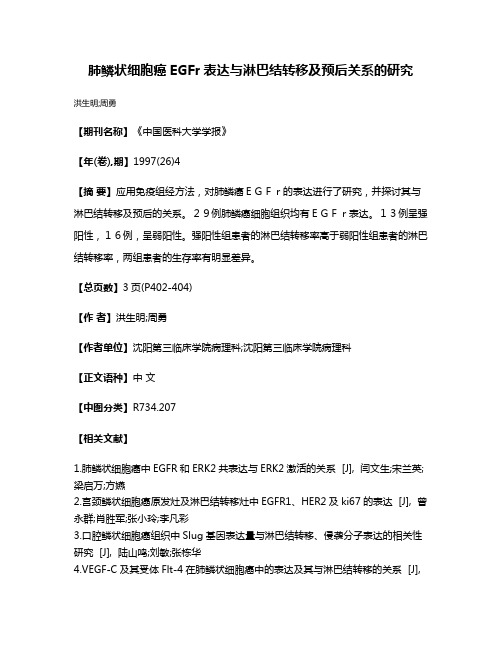
肺鳞状细胞癌EGFr表达与淋巴结转移及预后关系的研究洪生明;周勇
【期刊名称】《中国医科大学学报》
【年(卷),期】1997(26)4
【摘要】应用免疫组经方法,对肺鳞癌EGFr的表达进行了研究,并探讨其与淋巴结转移及预后的关系。
29例肺鳞癌细胞组织均有EGFr表达。
13例呈强阳性,16例,呈弱阳性。
强阳性组患者的淋巴结转移率高于弱阳性组患者的淋巴结转移率,两组患者的生存率有明显差异。
【总页数】3页(P402-404)
【作者】洪生明;周勇
【作者单位】沈阳第三临床学院病理科;沈阳第三临床学院病理科
【正文语种】中文
【中图分类】R734.207
【相关文献】
1.肺鳞状细胞癌中EGFR和ERK2共表达与ERK2激活的关系 [J], 闫文生;宋兰英;梁启万;方嬿
2.宫颈鳞状细胞癌原发灶及淋巴结转移灶中EGFR1、HER2及ki67的表达 [J], 曾永群;肖胜军;张小玲;李凡彩
3.口腔鳞状细胞癌组织中Slug基因表达量与淋巴结转移、侵袭分子表达的相关性研究 [J], 陆山鸣;刘敏;张栋华
4.VEGF-C及其受体Flt-4在肺鳞状细胞癌中的表达及其与淋巴结转移的关系 [J],
范志勤;苏建萍;庞作良
5.非小细胞肺癌患者中EGFR与TTF-1表达及与患者预后关系的研究 [J], 黄银梅;吴晓文;蔡东林;马宏武
因版权原因,仅展示原文概要,查看原文内容请购买。
肿瘤免疫治疗的临床研究进展
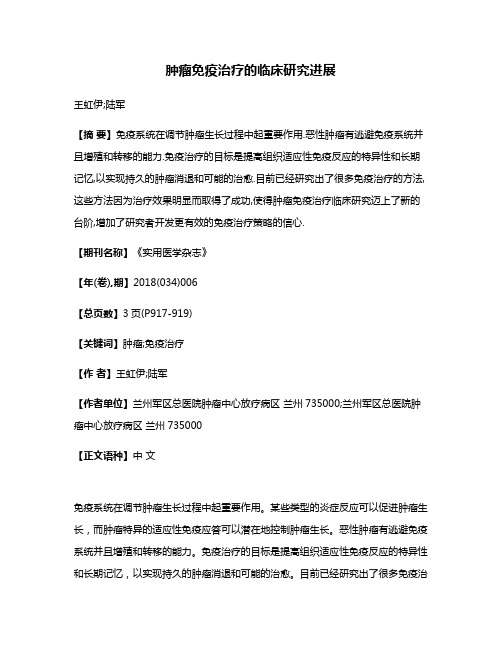
肿瘤免疫治疗的临床研究进展王虹伊;陆军【摘要】免疫系统在调节肿瘤生长过程中起重要作用.恶性肿瘤有逃避免疫系统并且增殖和转移的能力.免疫治疗的目标是提高组织适应性免疫反应的特异性和长期记忆,以实现持久的肿瘤消退和可能的治愈.目前已经研究出了很多免疫治疗的方法,这些方法因为治疗效果明显而取得了成功,使得肿瘤免疫治疗临床研究迈上了新的台阶,增加了研究者开发更有效的免疫治疗策略的信心.【期刊名称】《实用医学杂志》【年(卷),期】2018(034)006【总页数】3页(P917-919)【关键词】肿瘤;免疫治疗【作者】王虹伊;陆军【作者单位】兰州军区总医院肿瘤中心放疗病区兰州735000;兰州军区总医院肿瘤中心放疗病区兰州735000【正文语种】中文免疫系统在调节肿瘤生长过程中起重要作用。
某些类型的炎症反应可以促进肿瘤生长,而肿瘤特异的适应性免疫应答可以潜在地控制肿瘤生长。
恶性肿瘤有逃避免疫系统并且增殖和转移的能力。
免疫治疗的目标是提高组织适应性免疫反应的特异性和长期记忆,以实现持久的肿瘤消退和可能的治愈。
目前已经研究出了很多免疫治疗的方法,包括外源性细胞因子或治疗性疫苗的应用以增加肿瘤特异性T细胞的频率、肿瘤特异性免疫效应细胞的过继转移,以及最近应用各种免疫检查点抑制剂和共刺激激动剂受体以克服肿瘤诱导的免疫抑制机制,这些方法因为治疗效果明显而取得了成功,使肿瘤免疫治疗临床研究迈上了新的台阶,增加了研究者开发更有效的免疫治疗策略的信心。
本文详细讨论肿瘤免疫治疗目前的研究进展。
1 肿瘤免疫治疗的合理性长期以来人们一直认为,免疫系统和恶性细胞通常共存于动态平衡状态,并且生长的肿瘤与免疫系统之间的复杂相互作用可能决定疾病的过程[1]。
肿瘤必须发展其增殖和转移的能力来逃避免疫系统。
目前免疫监测研究理论表明,免疫系统能够主动消除异常细胞,预防体内癌变,而免疫功能受损或抑制的患者却增加了发生癌症的风险[2]。
2 肿瘤免疫治疗的目的肿瘤免疫治疗的目的是增强组织适应性免疫反应的特异性和长期记忆,用以提高或恢复免疫系统的能力,通过克服肿瘤逃避机制和抑制免疫反应,去检测和破坏癌细胞[1],以实现持久的肿瘤消退和可能的治愈。
中国人群肺鳞癌遗传变异谱研究

中国人群肺鳞癌遗传变异谱研究肺癌的发病率和死亡率均居所有恶性肿瘤的首位。
约85%的新诊断肺癌患者为非小细胞肺癌(non-small cell lung cancer, NSCLC)。
而肺鳞癌作为NSCLC的主要组织学类型之一,约占NSCLC患者的30%。
表皮生长因子受体酪氨酸激酶抑制剂(epidermal growth factor receptor tyrosine kinase inhibitor, EGFR-TKI)及间变淋巴瘤激酶(anaplastic lymphoma kinase, ALK)抑制剂的发现显著改善了具有EGFR敏感突变和ALK基因重排NSCLC患者的生存。
但是,这些靶向药物主要针对肺腺癌,对肺鳞癌则鲜有疗效。
而目前尚无针对肺鳞癌的靶向药物上市。
因此,在肺鳞癌中寻找药物可作用的分子靶点成为推进肺鳞癌靶向治疗研究的关键。
本研究通过对中国人群肺鳞癌基因突变和拷贝数变异的检测,旨在建立具有中国人群特征的肺鳞癌遗传变异谱,识别肺鳞癌中潜在的药物作用靶点,促进肺鳞癌靶向治疗的研究进程,提高我国肺鳞癌患者个体化治疗整体水平,推进肺鳞癌精准医疗的发展。
本论文研究内容分为两个部分:第一章:基于下一代靶向测序技术的肺鳞癌基因突变检测。
本部分研究以159例肺鳞癌为研究对象,采用Ion Torrent下一代靶向测序技术(targeted next-generation sequencing, NGS)检测50个癌基因和抑癌基因中约2,800个COSMIC突变位点。
分析肺鳞癌中基因突变与患者临床病理学特征、无疾病生存期(disease-free survival, DFS)及总生存期(overall survival, OS)的关系。
结果显示,在我国肺鳞癌中突变率最高的基因为TP53(56.0%,89/159),其次为CDKN2A(8.8%,14/159), PI3KCA (8.8%,14/159), KRAS (4.4%,7/159), EGFR (3.1%,5/159), FBXW7 (2.5%, 4/159), PTEN (2.5%,4/159), FGFR3 (1.3%,2/159), AKT1 (1.3%,2/159)及KIT(0.6%,1/159)。
肺鳞状细胞癌的未来治疗方向与创新疗法

论文题目:肺鳞状细胞癌的未来治疗方向与创新疗法摘要:肺鳞状细胞癌是一种常见的恶性肿瘤,其治疗面临诸多挑战。
本文综述了肺鳞状细胞癌的未来治疗方向与创新疗法,包括靶向治疗、免疫治疗、基因治疗、细胞治疗等方面的最新进展,展望了肺鳞状细胞癌治疗的未来发展方向。
引言:肺鳞状细胞癌是一种常见的肺癌亚型,其治疗效果相对较差,传统治疗手段的局限性日益显现。
因此,寻找新的治疗方法成为当前肺鳞状细胞癌研究的重点。
1. 靶向治疗靶向治疗是一种针对肿瘤特定靶点的治疗方法,具有较高的治疗效果和较低的毒副作用。
近年来,针对肺鳞状细胞癌的靶向药物不断涌现,如EGFR抑制剂、ALK抑制剂等,为肺鳞状细胞癌治疗带来了新的希望。
2. 免疫治疗免疫治疗是通过激活机体免疫系统来抑制肿瘤生长和扩散的治疗方法。
近年来,免疫检查点抑制剂在肺鳞状细胞癌治疗中取得了显著成效,如PD-1/PD-L1抑制剂和CTLA-4抑制剂等,提高了患者的生存率和生存质量。
3. 基因治疗基因治疗是利用基因工程技术修复或改变肿瘤细胞的遗传信息,从而达到治疗肿瘤的目的。
针对肺鳞状细胞癌的基因治疗研究正在不断深入,如基因靶向治疗、基因编辑治疗等,为肺鳞状细胞癌的治疗提供了新的思路和方法。
4. 细胞治疗细胞治疗是利用患者自身或外源性的免疫细胞来攻击和杀灭肿瘤细胞的治疗方法。
近年来,CAR-T细胞治疗在肿瘤治疗中取得了重大突破,为肺鳞状细胞癌的治疗带来了新的希望。
5. 联合治疗多种治疗方法的联合应用被认为是未来肺鳞状细胞癌治疗的重要方向。
靶向治疗与免疫治疗、免疫治疗与化疗、免疫治疗与基因治疗等联合治疗方案的研究正在进行中,为肺鳞状细胞癌的治疗提供了更多可能性。
6. 个体化治疗随着精准医学的发展,个体化治疗将成为肺鳞状细胞癌治疗的重要方向。
基于肿瘤基因型和表型的个体化治疗方案将为患者提供更为精准和有效的治疗策略。
结论:肺鳞状细胞癌的未来治疗方向与创新疗法包括靶向治疗、免疫治疗、基因治疗、细胞治疗等多个方面,为肺鳞状细胞癌患者带来了新的治疗希望。
肺鳞癌的诊疗进展

肺鳞癌的诊疗进展肺癌是最常见的癌症之一,也是导致癌症相关死亡的主要原因之一。
其中,鳞状细胞肺癌约占新诊断肺癌的30%,与腺癌有明显的区别。
鳞癌的发病与吸烟密切相关,且多为中央型,容易累及大血管,出现中心空泡和大出血,危及生命。
然而,随着化疗方案的不断优化、靶向药物的深入研究以及免疫治疗的巨大突破,鳞癌的治疗方法获得了更多的选择。
根据2019版XXX(CSCO)原发性肺癌诊疗指南,肺鳞癌患者尤其是吸烟患者的EGFR突变发生率低,因此不常规推荐驱动基因检测。
对于不能手术、局部晚期原发性NSCLC 患者,体能状态(PS)评分为2分时,推荐治疗策略由原先的单纯化疗改为放化疗结合。
考虑到药物疗效与可及性问题,将局部晚期患者同步放化疗后接受durvalumab巩固治疗作为Ⅲ级推荐。
此外,紫杉醇脂质体联合铂类被首次引入指南,作为驱动基因阴性NSCLC化疗方案的Ⅰ级推荐。
对于无驱动基因的鳞癌NSCLC,一线治疗中新增了两项免疫治疗:K药用于PDL1≥50%;K药+紫杉醇+铂类。
二线及三线治疗中,I级推荐新增O药治疗,II级、III级推荐新增K药及阿特珠单抗治疗。
三线治疗中,I级推荐为O药、多西他赛;II级推荐为安罗替尼。
对于早期肺鳞癌患者来说,手术切除仍然是首选治疗方法。
然而,对于不能手术的患者,立体定向放射外科(SBRT)也可以用于早期治疗。
从目前的生存率数据看,SBRT的疗效并不逊色于手术治疗,长期疗效仍在观察中。
为6.0个月vs 4.8个月,联合组较化疗组降低了44%的疾病进展风险。
这意味着,帕博利珠单抗联合化疗治疗转移性鳞状NSCLC的效果显著,为患者带来了更长时间的生存期和更好的生活质量。
在过去,无法手术的中晚期肺鳞癌患者主要接受根治性放化疗和随访治疗。
然而,随着PD-1/PD-L1为代表的免疫治疗的研究深入,Imfinzi和Durvalumab已经被XXX和XXX批准用于治疗不可切除的III期非小细胞肺癌患者。
驱动基因阳性肺癌脑转移患者的靶向治疗进展
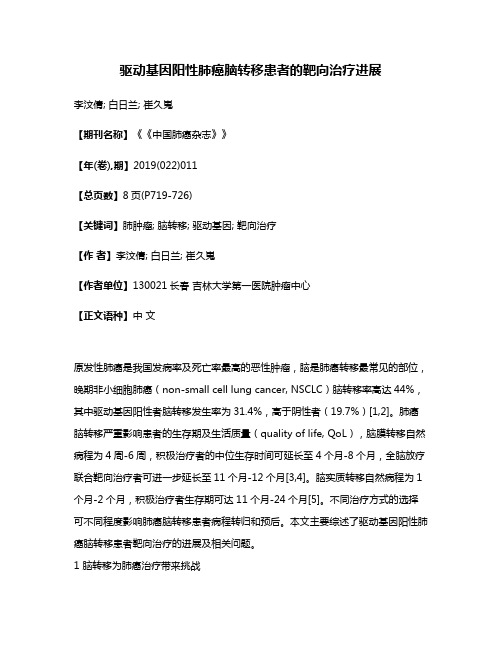
驱动基因阳性肺癌脑转移患者的靶向治疗进展李汶倩; 白日兰; 崔久嵬【期刊名称】《《中国肺癌杂志》》【年(卷),期】2019(022)011【总页数】8页(P719-726)【关键词】肺肿瘤; 脑转移; 驱动基因; 靶向治疗【作者】李汶倩; 白日兰; 崔久嵬【作者单位】130021长春吉林大学第一医院肿瘤中心【正文语种】中文原发性肺癌是我国发病率及死亡率最高的恶性肿瘤,脑是肺癌转移最常见的部位,晚期非小细胞肺癌(non-small cell lung cancer, NSCLC)脑转移率高达44%,其中驱动基因阳性者脑转移发生率为31.4%,高于阴性者(19.7%)[1,2]。
肺癌脑转移严重影响患者的生存期及生活质量(quality of life, QoL),脑膜转移自然病程为4周-6周,积极治疗者的中位生存时间可延长至4个月-8个月,全脑放疗联合靶向治疗者可进一步延长至11个月-12个月[3,4]。
脑实质转移自然病程为1个月-2个月,积极治疗者生存期可达11个月-24个月[5]。
不同治疗方式的选择可不同程度影响肺癌脑转移患者病程转归和预后。
本文主要综述了驱动基因阳性肺癌脑转移患者靶向治疗的进展及相关问题。
1 脑转移为肺癌治疗带来挑战脑转移为肺癌的治疗带来挑战:一方面,血脑屏障是中枢神经系统的天然屏障,在保护大脑不受有毒物质侵害的同时却限制了药物的可及性[6,7],另一方面,不同类型脑转移(脑实质转移和脑膜转移)诊断方式的选择影响其诊断率、治疗选择及预后。
增强磁共振成像(magnetic resonance imaging, MRI)是发现脑实质转移病灶的首选影像检查[8],但其诊断脑膜转移的灵敏度仅为76%,其中弥漫型软脑膜转移影像表现为阴性,而脑脊液检测对于脑膜转移敏感性及特异性较高[4,9,10]。
驱动基因阳性肺癌脑转移患者的诊断和治疗面临着进一步的挑战:首先,脑转移病灶与原发病灶存在基因异质性,研究[6]表明53%的脑转移瘤基因突变与原发病灶不一致,且在治疗中可出现获得性突变,产生耐药和疾病进展,为精准靶向药物的选择、治疗过程中动态监测耐药突变带来挑战。
25_肺鳞癌驱动基因研究

肺鳞癌驱动基因研究第一部分肺鳞癌概述及流行病学特征 (2)第二部分驱动基因在癌症发生中的作用机制 (5)第三部分肺鳞癌驱动基因的研究进展 (7)第四部分常见肺鳞癌驱动基因的分类与特点 (12)第五部分肺鳞癌驱动基因的功能研究方法 (13)第六部分肺鳞癌驱动基因的临床意义和应用价值 (17)第七部分靶向治疗与肺鳞癌驱动基因的关系 (21)第八部分展望:未来肺鳞癌驱动基因的研究方向 (22)第一部分肺鳞癌概述及流行病学特征肺鳞癌概述及流行病学特征肺鳞癌是一种常见的恶性肿瘤,其发病机制与基因突变密切相关。
肺鳞癌起源于气管、支气管和细支气管上皮细胞,主要表现为黏液分泌增多、表面粗糙以及不同程度的角化。
相较于其他类型的肺癌,如腺癌和小细胞肺癌,肺鳞癌更易发生局部侵犯和淋巴结转移,预后较差。
根据全球癌症统计报告,2018 年全球新发肺癌病例约 222 万例,其中非小细胞肺癌占据大多数(大约 85%),而肺鳞癌在非小细胞肺癌中占比约为 30%。
在中国,由于吸烟率较高和环境污染等因素的影响,肺鳞癌的发病率更高。
据统计,中国每年新增肺鳞癌患者超过 60 万人,占全部肺癌患者的 40%左右。
肺鳞癌的发生与多种因素有关,包括遗传因素、环境因素以及生活方式等。
其中,吸烟是导致肺鳞癌的主要危险因素之一。
长期大量吸烟的人患肺鳞癌的风险显著高于非吸烟者。
此外,空气污染、职业暴露、家族史、肺部感染和慢性阻塞性肺疾病等也与肺鳞癌的发生有一定的关联。
肺鳞癌通常在中老年人群中多见,男性比女性更容易患病。
研究显示,男性肺鳞癌的发病率是女性的 2-3 倍。
这种性别差异可能与吸烟行为和社会文化背景有关。
吸烟率较高的地区,男性肺鳞癌的发病率相应增加。
在全球范围内,亚洲国家是肺鳞癌高发区域,尤其是东亚地区。
以中国为例,尽管近年来肺癌整体死亡率呈现下降趋势,但肺鳞癌的死亡率仍然居高不下。
这提示我们需要进一步加强对肺鳞癌病因学的研究,以便采取更为有效的预防措施。
鳞状细胞癌的发生和转移规律的研究进展
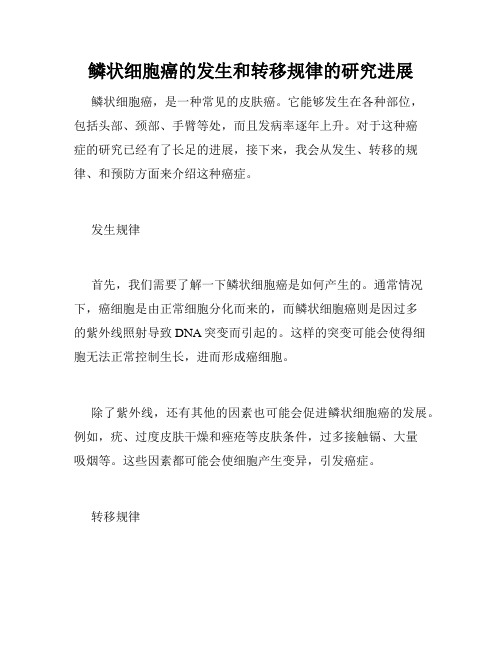
鳞状细胞癌的发生和转移规律的研究进展鳞状细胞癌,是一种常见的皮肤癌。
它能够发生在各种部位,包括头部、颈部、手臂等处,而且发病率逐年上升。
对于这种癌症的研究已经有了长足的进展,接下来,我会从发生、转移的规律、和预防方面来介绍这种癌症。
发生规律首先,我们需要了解一下鳞状细胞癌是如何产生的。
通常情况下,癌细胞是由正常细胞分化而来的,而鳞状细胞癌则是因过多的紫外线照射导致DNA突变而引起的。
这样的突变可能会使得细胞无法正常控制生长,进而形成癌细胞。
除了紫外线,还有其他的因素也可能会促进鳞状细胞癌的发展。
例如,疣、过度皮肤干燥和痤疮等皮肤条件,过多接触镉、大量吸烟等。
这些因素都可能会使细胞产生变异,引发癌症。
转移规律鳞状细胞癌的转移过程中,通常会影响到淋巴系统和血液循环。
一旦癌细胞扩散到淋巴节点,那么它们就有可能通过 lymph 格网络进入到身体其他区域。
事实上,淋巴结是一个特别喜欢吸取鳞状细胞癌的癌细胞的地方。
另一方面,它们也有可能通过血液系统扩散到其他部位,并在那里生长并引发微转移。
当微转移累积到一定规模时,它们就会开始惊恐地生长,形成肿瘤。
当肿瘤进一步增长并开始压迫周围组织时,便会出现鳞状细胞癌的症状了。
预防方案对于鳞状细胞癌,最好的防范办法就是奉行防晒措施。
这包括涂防晒霜、遮阳帽、太阳镜,或者是尽量避免在太阳过于毒辣的时候外出。
对于那些在户外工作的人,最好是在处于阴凉的地方或者使用带有抗紫外线的衣服和配件。
此外,定期皮肤检查是检测这种癌症的好方式。
这样,在癌症症状还没有出现之前,医生就能及早探测到变化,并给与医疗上的帮助和建议。
总结鳞状细胞癌是一种严重的皮肤病,但它是可以被预防和治疗的。
要避免癌症对你的身体造成持久的伤害,防晒措施和定期体检都是必要的。
如果你怀疑自己长了类似肿瘤的东西,那么请务必尽早就医,以保证身体健康。
驱动基因阳性非小细胞肺癌免疫治疗进展

驱动基因阳性非小细胞肺癌免疫治疗进展邓仁芳;曾月;潘越;胡春宏;吴芳【期刊名称】《中国肺癌杂志》【年(卷),期】2022(25)3【摘要】肺癌是目前世界上致死率最高的恶性肿瘤,其中约80%为非小细胞肺癌(non-small cell lung cancer,NSCLC)。
大部分NSCLC患者伴有“驱动基因突变”,针对突变基因的靶向治疗可取得较好的疗效,但仍有部分患者在治疗后会出现进展或复发,预后较差。
已有的研究表明,免疫检查点抑制剂可改善晚期NSCLC的预后,延长患者生存期。
但对于具有不同免疫微环境和分子特性的NSCLC患者,免疫治疗的效果差异较大。
其中免疫治疗在驱动基因阳性的NSCLC患者中的地位存在比较大的争议。
本文对驱动基因阳性NSCLC的免疫特点及免疫治疗在驱动基因阳性患者中的应用前景和挑战进行综述。
【总页数】6页(P201-206)【作者】邓仁芳;曾月;潘越;胡春宏;吴芳【作者单位】中南大学湘雅二医院肿瘤中心;株洲市二医院肿瘤一科;肿瘤大数据智能化应用湖南省工程研究中心;肿瘤模型与个体化诊治研究湖南省重点实验室;肺癌早期诊断与精准治疗湖南省重点实验室【正文语种】中文【中图分类】R73【相关文献】1.晚期非小细胞肺癌ALK融合基因及其他少见驱动基因阳性靶向治疗进展2.晚期非小细胞肺癌ALK融合基因及其他少见驱动基因阳性靶向治疗进展3.常见驱动基因阳性晚期非小细胞肺癌免疫治疗现状4.驱动基因阴性晚期非小细胞肺癌脑转移免疫微环境及免疫治疗的研究进展5.《中国肿瘤临床》文章推荐:驱动基因阴性晚期非小细胞肺癌脑转移免疫微环境及免疫治疗的研究进展因版权原因,仅展示原文概要,查看原文内容请购买。
常见驱动基因阳性晚期非小细胞肺癌免疫治疗现状
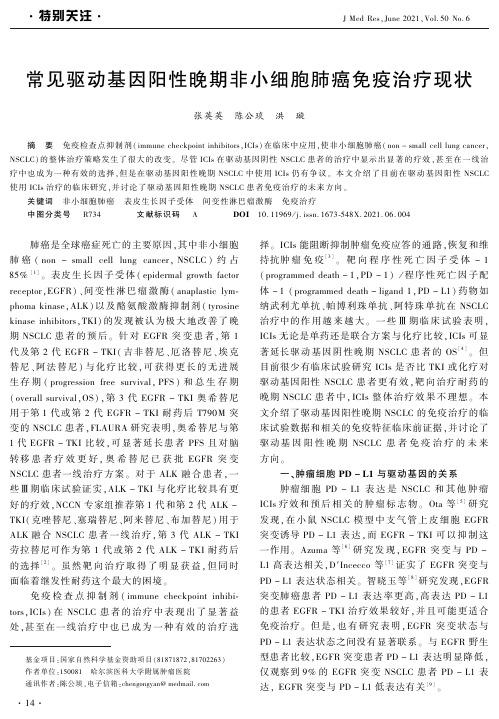
J Med Res,June 2021,Vol. 50 No. 6
常见驱动基因阳性晚期非小细胞肺癌免疫治疗现状
张英英 陈公琰 洪 璇
摘 要 免疫检查点抑制剂( immune checkpoint inhibitors,ICIs) 在临床中应用,使非小细胞肺癌( non - small cell lung cancer, NSCLC) 的整体治疗策略发生了很大的改变。 尽管 ICIs 在驱动基因阴性 NSCLC 患者的治疗中显示出显著的疗效,甚至在一线治 疗中也成为一种有效的选择,但是在驱动基因阳性晚期 NSCLC 中使用 ICIs 仍有争议。 本文介绍了目前在驱动 基 因 阳 性 NSCLC 使用 ICIs 治疗的临床研究,并讨论了驱动基因阳性晚期 NSCLC 患者免疫治疗的未来方向。
二、常见驱动基因阳性晚期 NSCLC 患者免疫检 查点抑制剂单药治疗
目前,一些 Ⅲ 期 临 床 试 验 将 ICIs 与 多 西 他 赛 作 为驱动基因阳性晚期 NSCLC 患者二线或三线治疗方 案进行了 比 较。 Checkmate 057 研 究 亚 组 结 果 显 示, 在 EGFR 突变患者中,纳武利尤单抗与多西他赛比较 没有带来显著的 PFS 延长[13] 。 OAK 研究与 POPLAR 研究亚组分析结果均提示,在 EGFR 突变晚期 NSCLC 患者中,阿特珠单抗治疗组与化疗组比较 OS 没有明 显获益 [14,15] 。 KEYNOTE - 010 研 究 是 一 项 开 放 标 签 Ⅱ / Ⅲ期临床试验,亚组结果显示,帕博利珠单抗组与 多西他赛组比 较,未 给 EGFR 突 变 NSCLC 患 者 带 来 生存获益[16] 。 回 顾 性 研 究 表 明, 与 EGFR 野 生 型 比 较,EGFR 突变 NSCLC 患者对 ICIs 疗效较差,在一项 研究 中 观 察 到, 22 例 接 受 免 疫 治 疗 的 EGFR 突 变 NSCLC 患 者 的 客 观 缓 解 率 ( objective response rate, ORR) 为 4. 5% ,而 30 例 EGFR 野生型患者的 ORR 为 23. 3% [17] 。 Mazieres 等[18] 研 究 发 现, 在 115 例 接 受 免疫治疗 的 NSCLC 患 者 中,ORR 为 12% , 中 位 PFS
《2024年肺鳞癌特异性预后标志物探索与鉴定》范文

《肺鳞癌特异性预后标志物探索与鉴定》篇一一、引言肺鳞癌是一种常见的肺癌类型,其发病率和死亡率均较高。
由于肺鳞癌的异质性,其预后效果往往因个体差异而有所不同。
因此,寻找特异性预后标志物,对于肺鳞癌的早期诊断、治疗选择及预后评估具有重要意义。
本文旨在探索与鉴定肺鳞癌特异性预后标志物,以期为临床诊断和治疗提供新的思路和方法。
二、文献综述近年来,关于肺鳞癌特异性预后标志物的研究日益增多。
通过对相关文献的梳理,我们发现目前研究主要集中在以下几个方面:基因突变、蛋白质组学、免疫组化等。
其中,基因突变是研究最为广泛的领域,如EGFR、KRAS等基因的突变情况与肺鳞癌的预后密切相关。
然而,由于肺鳞癌的异质性,单一标志物的准确性和特异性仍有待提高。
因此,综合多种标志物进行预后评估可能更具价值。
三、方法本研究采用多组学联合分析的方法,对肺鳞癌组织进行基因、蛋白质及免疫组化等方面的检测。
首先,收集肺鳞癌患者的肿瘤组织及正常组织样本;其次,利用高通量测序技术对样本进行基因突变检测;然后,通过蛋白质组学分析,鉴定与肺鳞癌发生、发展及预后相关的蛋白质;最后,利用免疫组化技术对关键蛋白质进行定位和定量分析。
四、结果通过对肺鳞癌组织的多组学分析,我们鉴定出多个与预后相关的标志物。
其中,基因层面的EGFR、KRAS等基因的突变情况与患者预后密切相关;在蛋白质组学层面,我们发现某些与细胞增殖、凋亡、免疫反应等相关的蛋白质表达水平与肺鳞癌的预后具有显著相关性;在免疫组化层面,我们成功定位和定量分析了关键蛋白质在肿瘤组织中的表达情况,为进一步探讨其与预后的关系提供了基础。
五、讨论本研究通过多组学联合分析的方法,成功鉴定出多个与肺鳞癌预后相关的标志物。
这些标志物不仅包括基因层面的突变情况,还包括蛋白质层面的表达水平和免疫组化层面的定位分析。
这些发现为进一步探讨肺鳞癌的发病机制、诊断和预后评估提供了新的思路和方法。
然而,本研究仍存在一定局限性。
ABCG2、VEGF-C及Cyclin-D1在肺鳞癌组织中的表达与意义的开题报告
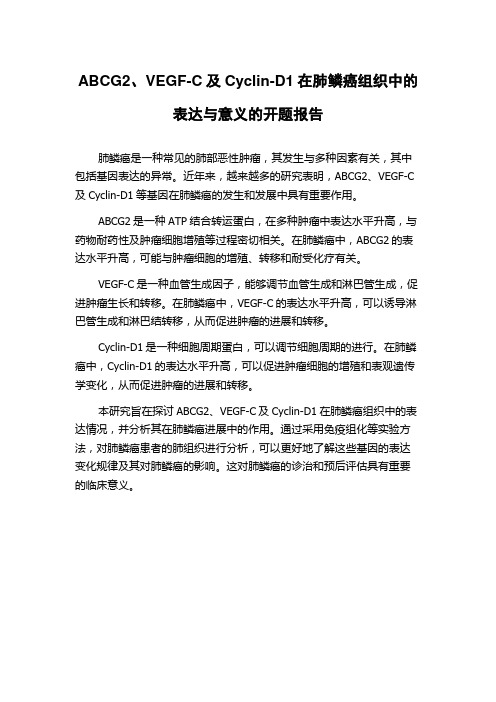
ABCG2、VEGF-C及Cyclin-D1在肺鳞癌组织中的
表达与意义的开题报告
肺鳞癌是一种常见的肺部恶性肿瘤,其发生与多种因素有关,其中包括基因表达的异常。
近年来,越来越多的研究表明,ABCG2、VEGF-C 及Cyclin-D1等基因在肺鳞癌的发生和发展中具有重要作用。
ABCG2是一种ATP结合转运蛋白,在多种肿瘤中表达水平升高,与药物耐药性及肿瘤细胞增殖等过程密切相关。
在肺鳞癌中,ABCG2的表达水平升高,可能与肿瘤细胞的增殖、转移和耐受化疗有关。
VEGF-C是一种血管生成因子,能够调节血管生成和淋巴管生成,促进肿瘤生长和转移。
在肺鳞癌中,VEGF-C的表达水平升高,可以诱导淋巴管生成和淋巴结转移,从而促进肿瘤的进展和转移。
Cyclin-D1是一种细胞周期蛋白,可以调节细胞周期的进行。
在肺鳞癌中,Cyclin-D1的表达水平升高,可以促进肿瘤细胞的增殖和表观遗传学变化,从而促进肿瘤的进展和转移。
本研究旨在探讨ABCG2、VEGF-C及Cyclin-D1在肺鳞癌组织中的表达情况,并分析其在肺鳞癌进展中的作用。
通过采用免疫组化等实验方法,对肺鳞癌患者的肺组织进行分析,可以更好地了解这些基因的表达变化规律及其对肺鳞癌的影响。
这对肺鳞癌的诊治和预后评估具有重要的临床意义。
肺癌精准治疗与转化研究新进展答案-2024年华医网继续教育

肺癌精准治疗与转化研究新进展答案2024年华医网继续教育目录一、早期肺癌的精细化诊疗和转化研究 (1)二、临床视角:IB期EGFR突变NSCLC的辅助治疗 (3)三、少见突变NSCLC治疗进展及思考 (7)四、抗体偶联药物在NSCLC中的运用 (9)五、肺癌局部介入消融治疗的应用——着眼局部,控制大局 (11)六、类器官在肺癌领域的研究和应用 (13)七、肺癌分子病理检测的指南与实践 (14)八、肺癌脑转移的研究现状 (16)九、恶性胸膜间皮瘤治疗新进展 (20)十、免疫时代的外科临床思考 (22)十一、免疫联合治疗的临床和转化研究 (24)十二、免疫治疗耐药机制和应对策略 (25)十三、免疫治疗生物标志物的探索 (27)一、早期肺癌的精细化诊疗和转化研究1.ctDNA甲基化相比突变的最大优势是?A.稳定B.数量大C.易分析D.分子小E.长度短参考答案:B2.肺癌辅助化疗提高多少5年生存率?A.0.05B.0.1C.0.15D.0.2E.0.25参考答案:A3.肺结节中恶性比例为?A.0.3B.0.2C.0.1D.0.05E.<5%参考答案:E4.目前肺癌筛查的标准工具是?A.LDCTB.X rayC.CEA、cyfra21-1D.纤支镜E.PET-CT参考答案:A5.EGFR突变的术后辅助治疗首选?A.化疗B.放疗C.靶向治疗D.免疫治疗E.细胞治疗参考答案:C二、临床视角:IB期EGFR突变NSCLC的辅助治疗1.基于EVIDENCE研究,埃克替尼在国内获批适应症A.单药适用于IB-IIIA期EGFR突变NSCLC术后辅助治疗B.用于ⅠB-ⅢA期存在EGFR外显子19缺失或外显子21(L858R)突变的NSCLC术后辅助治疗C.单药可试用于治疗既往接受过至少一个化疗方案失败后的局部晚期或转移性NSCLCD.用于ⅠI-ⅢA期存在EGFR外显子19缺失或外显子21(L858R)突变的NSCLC术后辅助治疗E.单药适用于II-IIIA期EGFR突变NSCLC术后辅助治疗参考答案:E2.根据NCCN指南(2022年第5版),以下高危因素描述不正确的是A.低分化肿瘤(肺神经内分泌肿瘤[包括高分化神经内分泌肿瘤])B.楔形切除C.脏层胸膜浸润D.肿瘤>4cmE.淋巴结状态未知(Nx)参考答案:A3.关于I期NSCLC患者生存的影响因素,以下说法不正确的是A.与楔形切除术相比,肺叶切除术和肺段切除术在总生存率方面具有显著优势B.肺叶切除术和肺段切除术的3年或5年生存率存在显著差异C.肺叶切除术比亚肺叶切除患者有更好的生存D.对IB期患者肺叶切除后辅助化疗是更有效的治疗模式E.手术切除方式是影响I期NSCLC患者生存的最主要因素参考答案:B4.JACC第八版分期Ib期(T2aN0M0)患者的生存率约为A.77%B.68%C.53%-65%D.60%E.36%参考答案:B5.以下哪类患者可能不能从术后辅助化疗中获益A.肿瘤直径<4cmB.IB期有高危因素的C.肿瘤直径≥4cmD.II期E.III期参考答案:A1.晚期NSCLC一线EGFR-TKI耐药后的治疗策略2.对于没有敏感突变基因突变的EGFR-TKI耐药患者来说,选择哪种治疗方式可能会获得较好疗效?A.铂类为基础的两药化疗B.抗血管治疗C.免疫治疗D.抗血管联合免疫E.免疫+化疗+抗血管参考答案:E3.下列哪两个基因突变可能会导致非小细胞肺癌向小细胞肺癌的转化?A.RB1和TP53B.RB1和C797SC.RB1和METD.RB1和RETE.RET和TP53参考答案:A4.目前市面可及的三代EGFR-TKI药物OS最长超过多长时间?A.2年B.3年C.2.5年D.4年E.5年参考答案:B5.对于EGFRmNSCLC患者使用奥希替尼治疗后出现T790M和C797S突变且为顺式模式,可以使用下列那种药物治疗?A.BrigatinibB.阿法替尼C.阿美替尼D.奥希替尼E.吉非替尼参考答案:A6.对于EGFRmNSCLC患者使用奥希替尼治疗后出现T790M和C797S突变且为反式模式,可以使用下列那种组合药物治疗?A.吉非替尼+埃克替尼B.吉非替尼+阿法替尼C.埃克替尼+达克替尼D.吉非替尼+奥希替尼E.阿美替尼+奥希替尼参考答案:D三、少见突变NSCLC治疗进展及思考1.治疗少见突变晚期NSCLC的抗肿瘤药物不包括以下哪种IB.双特异性抗体C.内分泌治疗药物D.ADCE.免疫检查点抑制剂参考答案:C2.以下叙述错误的是A.少见突变NSCLC围手术期靶向治疗的地位已确立B.不同TKI药物的耐药机制存在差异C.一种靶向药物可能可同时抑制不同的少见突变基因变异D.同一种驱动基因变异可在不同病理类型的实体瘤中发生E.以靶向少见突变的特异性抑制剂为主的联合治疗或可延缓耐药发参考答案:A3.以下描述错误的是A.液体活检相比于组织活检,具有克服肿瘤组织的异质性、样本可及性高、样本类型多、微创等优点,所以液体活检优于组织活检。
肺鳞癌基因的研究进展

[ 1 3 ]王禾, 张建华. 四君子汤免疫药理作用的研究进展[ J ] . 北京中医,
( 3 ) : 1 7 9 . 【 1 2 ]B o e r W. C t o k i n e s a n d t h e r a p y i n C O P D[ J ] . C h e s t , 2 0 0 2 , 1 2 1 ( 5 S u p p 1 ) :
【 摘 要 】 非 小细胞 肺癌 ( N S C L C)是 常见 的肺癌 类型 ,约 占肺癌 总 数 的 8 5 %,其 中大概 有 3 0 % 是 鳞 状细 胞癌 ( S Q C C)亚型 。尽 管 分子靶 向治 疗 大大 改善 了腺癌 患者 的预 后 ,但 目前依 然没有 针对 鳞癌 的特 异靶 向 治疗 药物 。 已有 大量 文献 报道 肺鳞 癌细 胞 中基 因分子 发生 明显 变 化 。 本文 综述 了肺鳞 状 细胞 癌 中相 关基 因 分子 的 变化 ,其 中某 些 分子可 能在 不久 的将 来成 为鳞 癌 临床 治疗 的靶 向 分子 。 【 关键词 】 非 小细 胞肺癌 ;肺鳞状 细 胞癌 ;基 因改 变
【 1 6 ] 申志 强, 黄 立 新. 黄芪 治 疗选 择性 免疫 球 蛋 白A缺乏 【 J ] . 新药 与 临
床, 1 9 9 7 , 1 6 ( 4 ) : 2 4 6 — 2 4 7 .
肺鳞癌基 因的研究进展
丁 矢 张 艳 平 杨 杰
( 常德职业技术学 院医学 系 ,湖南 常德 4 1 5 0 0 0 )
- 1、下载文档前请自行甄别文档内容的完整性,平台不提供额外的编辑、内容补充、找答案等附加服务。
- 2、"仅部分预览"的文档,不可在线预览部分如存在完整性等问题,可反馈申请退款(可完整预览的文档不适用该条件!)。
- 3、如文档侵犯您的权益,请联系客服反馈,我们会尽快为您处理(人工客服工作时间:9:00-18:30)。
中国肺癌杂志2014年5月第17卷第5期Chin J Lung Cancer, May 2014, Vol.17, No.5·综述·肺鳞癌驱动基因研究进展洪卫 综述 张沂平 审校【摘要】 肺癌在癌症相关死亡中是居于首位的恶性肿瘤。
鳞癌是仅次于腺癌的非小细胞肺癌(non-small cell lung cancer, NSCLC )最常见的组织学类型。
一些负责恶性肿瘤的发生和维持相关分子改变被称为驱动基因。
近来研究证实肺鳞癌也具有与致癌作用及靶向药物疗效有关的独特分子特征。
目前发现约40%肺鳞癌已经找到驱动基因,其中纤维母细胞生长因子受体1(fibroblast growth factor receptor 1, FGFR1)起重要作用。
本文将对肺鳞癌驱动基因进行综述。
【关键词】 肺肿瘤;鳞癌;癌基因Advances on Driver Oncogenes of Squamous Cell Lung CancerWei HONG, Yiping ZHANGZhejiang Cancer Hospital, Zhejiang Key Laboratory of the Diagnosis & Treatment Technology on Thoracic Oncology,Hangzhou 310022, ChinaCorresponding author: Yiping ZHANG, E-mail: zyp@【Abstract 】 Background and objective Lung cancer is the leading cause of cancer-related deaths worldwide. Next to adenocarcinoma, squamous cell carcinoma (SCC) of the lung is the most frequent histologic subtype in non-small cell lung cancer. Several molecular alterations have been defined as "driver oncogenes" responsible for both the initiation and mainte-nance of the malignancy. The squamous cell carcinoma of the lung has recently shown peculiar molecular characteristics which relate with both carcinogenesis and response to targeted drugs. So far, about 40% of lung squamous cell carcinoma has been found harbouring driver oncogenes, in which fibroblast growth factor receptor 1 (FGFR1) plays important roles. In this review, we will report the mainly advances on some latest driver mutations of squamous cell lung cancer.【Key words 】 Lung neoplasms; Squamous cell carcinoma; OncogenesThis study was supported by grants from Zhejiang Provincial Natural Science Foundation (to Yiping ZHANG)(No.LY13H160024), Development Center for Medical Science and Technology, Ministry of Health (to Yiping ZHANG)(No.W2012FZ134) and the Medical Scientific Research Foundation of Zhejiang Province (to Wei HONG)(No.2012KYA023).DOI: 10.3779/j.issn.1009-3419.2014.05.13本研究受浙江省自然基金(No.LY13H160024)、卫生部医药卫生科技发展研究中心课题(No.W2012FZ134)及浙江省医药卫生科学研究基金(No.2012KYA023)资助作者单位:310022 杭州,浙江省肿瘤医院,浙江省胸部肿瘤诊治技术研究重点实验室(通讯作者:张沂平,E-mail: zyp@ )癌基因成瘾(oncogene addiction )是指某些肿瘤维持其恶性生物学表型依赖于某个或某些活化癌基因的现象,这些癌基因也称为驱动癌基因(driver oncogenes )[1]。
癌细胞需要驱动癌基因持续发挥功能,而正常细胞则不需要。
因此,以癌基因为治疗靶点,可以使靶向药物特异性地杀伤肿瘤细胞,而不损伤正常细胞。
肺癌居全球范围内癌症死亡原因的首位,非小细胞肺癌(non-small cell lung cancer, NSCLC )约占肺癌的80%,鳞癌是仅次于腺癌的NSCLC 最常见的组织学类型,导致全世界每年约有40万患者死亡[2]。
2004年世界卫生组织(World Health Organization, WHO )的分类中,将鳞癌分为乳头状、基底样、透明细胞及小细胞4种亚型。
一般认为,肺鳞癌均表达癌基因p63而不表达甲状腺转录因子-1(thyroid transcription factor-1, TTF-1)。
多项研究[3-5]认为,P40(DeltaNp63),P63的同型异构体抗体,对诊断肺鳞癌特异性更高。
以驱动基因为靶点的肺腺癌的治疗新进展使得人们对靶向治疗充满憧憬,例如多个表皮生长因子受体酪氨酸激酶活性抑制剂(epidermal growth factor receptor tyrosine kinase inhibitor, EGFR-TK I )在治疗EGFR 基因突变的NSCLC [6-9]以及克唑替尼(crizotinib )治疗棘皮动物微管相关蛋白样4-间变淋巴瘤激酶融合基因阳性(echinodern microtubule-associated protein-like 4 anaplastic lymphoma kinase, EML4-ALK )的晚期NSCLC ,均取得突出疗效,有效率可以高达60%-80%[10]。
尽管肺鳞癌的研究进展较中国肺癌杂志2014年5月第17卷第5期Chin J Lung Cancer, May 2014, Vol.17, No.5慢,但近年仍取得了一些进展[2],本文对肺鳞癌驱动基因的研究进展作一综述。
1驱动基因筛查研究近年来,系统地进行肺鳞癌驱动基因的研究比较少。
一项来自癌症基因组图谱研究网络(Cancer Genome Atlas Research Network, CGARN)的研究,对包括178例初治肺鳞癌进行表观基因组学和基因组学研究,已经发表的包括18个基因的结果表明,发现平均每个标本有360个外显子突变,165个基因重排,323个基因拷贝数异常。
抑癌基因TP53突变几乎见于所有的标本,并存在多种的信号通路异常,包括泛素连接酶复合体衔接蛋白1(Kelch-like ECH-associated protein 1, KEAP1)/小鼠核因子E2相关蛋白2(Rat nuclear factorerythroid 2-related factor 2, NFE2L2)占所有标本的34%,鳞癌分化基因占44%,磷脂酰肌醇3-激酶/蛋白激酶B/哺乳动物雷帕霉素靶蛋白(phosphatidylinositol-3-kinase/protein kinase B/mammalian target of Rapamycin, PI3K/Akt/mTOR)信号通路占47%等[2]。
而更早期的一项磷酸酪氨酸信号通路的研究[11]中,包括41个NSCLC细胞株和多达150个标本,揭示多种激酶通路的基因组学异常,包括盘状结构域受体(discoidin domain receptor tyrosine kinase, DDR)1和2,血管内皮生长因子受体(vascular endothelial growth factor receptor, VEGFR)1和2,血小板源性生长因子受体α多肽(platelet-derived growth factor receptor alpha, PDGFRα)等。
这些异常的发现使得靶向肺鳞癌的治疗成为可能。
2肺鳞癌驱动基因尽管已经筛查发现许多肺鳞癌的差异表达基因,但目前比较公认的并已经进入临床研究驱动基因并不多,简述如下。
2.1 FGFR1 纤维母细胞生长因子受体1(fibroblast growth factor receptor 1, FGFR1)是FGFR家族成员(包括FGFR1、FGFR2、FGFR3、FGFR4)之一,是一种酪氨酸跨膜激酶受体,编码基因位于8p12[12],在正常生理功能中有重要作用,参与胚胎的发育、细胞增殖、分化和血管生成。
它通过4条通路来调节,即MAPK、PI3K-AKT、STAT及磷脂酶Cγ[13]。
通过荧光原位杂交(fluorescence in situ hybridization, FISH)方法,Weiss及其研究小组[14]首次报道:在155例肺鳞癌标本中22%例标本存在FGFR1扩增,而581例非鳞癌患者中,仅1%存在FGFR1基因扩增。
结果提示,FGFR1扩增可能是肺鳞癌特有的分子标志。
进一步动物试验中发现在裸鼠致瘤模型中运用FGFR1抑制剂PD173074可使存在FGFR1基因扩增的肺鳞癌小鼠的肿瘤明显缩小,肺癌细胞的生长依赖于FGFR1的扩增。
其他研究小组的研究[14,15]也发现,肺鳞癌FGFR1的扩增的比例约20%,而腺癌则小于5%。
因此,目前研究认为FGFR1是肺鳞癌驱动基因。
有研究[16]检测262例肺鳞癌标本,发现肺鳞癌FGFR1扩增与吸烟相关,正吸烟、曾吸烟及从不吸烟者,扩增比例分别为28.9%、2.5%和0,这需要进一步观察验证。
韩国的这项研究还发现,在手术切除的标本中检测到FGFR1扩增的患者预后明显(无疾病生存时间26.9个月 vs 94.6个月,总生存时间51.2个月 vs 115个月)[14]。
